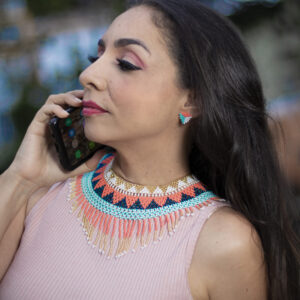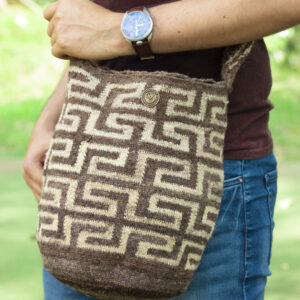
BAGS














NEW ARRIVALS
-
Zenú (Caña Flecha)
Bolso Caña Flecha Estilo Diamante
$90.00Original price was: $90.00.$75.00Current price is: $75.00.
Meet our tribes
Watch these videos and explore the rich cultural heritage of Colombia. Gain insights into the traditional craftsmanship and intricate techniques used in the creation of these exquisite handmade products. Immerse yourself in the vibrant world of Colombian culture and discover the fascinating stories behind these beautiful creations.
The Wayuu People
Zenu Tribe
Tejedoras Arhuacas
Here are some questions that are interesting and worth exploring:
The Wayuu mochila is a traditional bag from the Wayúu indigenous people of La Guajira, Colombia. Hand-stitched by skilled artisans, these vibrant bags represent Wayúu culture and serve a practical purpose. Each mochila is a unique work of art, symbolizing ancestral traditions. Today, it is internationally recognized for its beauty and craftsmanship, showcasing the rich artistic heritage of the Wayúu people.
In the present day, all Wayuu bags are crafted using acrylic material. This acrylic is procured from renowned thread manufacturers who specialize in producing a vast array of vibrant colors. This ensures that Wayuu bags are available in a wide range of hues to cater to diverse preferences.
The skilled Wayuu artisans use a crochet needle to wrap knots around threads, creating colorful bags that represent their cultural heritage. This technique adds beauty and durability to purses.
The time required to weave a long Wayuu bag can vary depending on the method used. The bag can be crocheted with either one or two strands of thread. When weaving with one strand, an artisan, depending on their skill level, can take anywhere from 18 to 25 days. This method produces a neater weaving pattern, and only a few artisans choose to weave with one strand. In contrast, weaving a long Wayuu bag with two strands of thread can take approximately 10 to 15 days. The resulting fabric is thicker, and more artisans prefer this method of weaving.
Typically, the production of a single mochila involves both men and women. Specifically, the man is responsible for making the strap, while the woman is in charge of crafting the bucket bag.
The Pueblo Arhuaco is located in northern Colombia, in the Sierra Nevada de Santa Marta.
The colors used to weave the mochilas are earth tones, which include shades of brown, beige, black, and gray. Initially, these mochilas were woven using natural fibers sourced from the Arhuaco lands, such as agave, cotton, and sheep wool.
In the Arhuaco culture, only women weave, while men are dedicated to agriculture. Girls start weaving at the age of 4 in order to preserve their culture. The backpacks they weave are all white and symbolize the purity of their soul and the peaks of the Sierra Nevada. These bags are called Bunsi, and the weaving technique is known as “point to point” because it involves creating knots using a capotera needle.
We are convinced that the balance of humanity comes from the respect for other beings and cultures. We consider our home, the tall Sierra, to be the heart of the world and all organisms to be our siblings. Every element that comes from the earth has a spirit and a purpose.
As the inhabitants of this land, we are known as the older brothers and have the mission of preserving the world and its harmony. Those who reside outside of the Sierra are known as younger brothers. We believe the world is dying because our younger brothers are not interested in protecting the Earth.
The sombrero Vueltiao is more than just a hat; it is the traditional straw hat of Colombia and a significant fashion symbol in the country. Its popularity is such that in 2004, the government declared it a national symbol. This sombrero is an iconic fashion accessory. It is crafted from caña flecha, a tall grass native to the Caribbean coast.
The Zenu tribe is known for producing and circulating the Vueltiao Hat, but in the town of Tuchin in Cordoba, it is known as the capital of the Vueltiao hat. It is a village where artisans produce more than 1,000 Vueltiao hats a day. Despite having a population of only 40,000 people, 90% of them work in this specialized production.
I am proud to know that international personalities such as Pope John Paul II, during his visit to Colombia in 1986, Bill Clinton in 2000, and Prince Charles of England in 2014, have all received the Vueltiao Hat as a symbol of welcome to the country. Additionally, in the movie “On Golden Pond,” the renowned actress Katharine Hepburn wore a Vueltiao H













